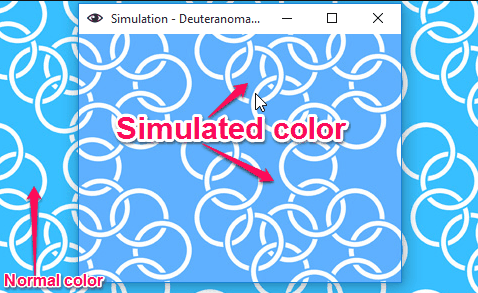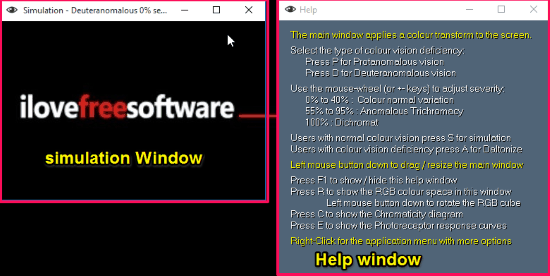Color-simulations is a free color simulator software to see how color vision deficient person sees a design. It is a very intuitive software for designers to know how a color vision deficient person might see their design. It basically creates a simulation window inside which you can see how a color vision deficient person sees colors. This Simulation window can be hovered anywhere on the screen to see the difference. You can choose between Protanomalous vision or Deuteranomalous vision to see the simulations for Protanopia and Deutranopia respectively. You can adjust severity of both the conditions so that it can simulate colors accordingly.
People with these conditions can also use this software to see colors more clearly.
About 5% population of the world suffers from some kind of color vision deficiency. So a design with great colors might not look so great to one in every 20 person as they cant see the true color. So designers nowadays need color simulators to see if the design also looks good to that 5% color deficient people or not. And, Color Simulations helps the designers in this noble cause.

Use This Color Simulator To See How Color Vision Deficient person Sees A Design:
Colour Simulation is an useful color simulator to see how a color vision deficient person sees it. It can be used to simulate color according to varying severity of color vision deficiency. It is a lightweight software as its of less than 2 MB.
On running the software, a Color Simulation window pops up with a Help window next to it. Very intuitively this Help window works as a user manual so that you don’t face any problem using the software.
You can avail all its features through right click context menu or you can use all the hotkeys mentioned next to the features in the context menu. However, first you will need to select either Protanomalous or Deutreanamalous, so that it can simulate color accordingly. You can increase or decrease severity of both these conditions using mouse wheel or “+”, “-” keys. Normal viewers always need to select Simulation to actually make it work.

As I mentioned earlier, this software can also be used by color deficient people to view colors more clearly. In context menu there are many tools for that as well. These tools are:
- Daltonize: This option basically exposes color details, which a color vision deficient person would have missed otherwise.
- Inverse Transform: It transforms color inversely to help color blind people see better.
- Swap Red and Blue: This tool swaps red color to blue, so that these people don’t miss on details.
- Other Color Effects: You can also customize color effects like Color Swap, Color Filter, Invert colors, Greyscale, Brightness, Saturation, Contrast, etc.
- Color Space Window: This tool shows different types of color profiles like RGB Cube, Chromatic Diagram, and Photo-Receptor Response Curve.
Note: Mouse Wheel and “+” or “-” keys work for increasing or decreasing all the above mentioned effects.
You can also checkout these useful software:
- Convert Photo to Artwork Using Facebook Messenger Filters.
- Multi Messenger Chrome App to Use WhatsApp, Facebook, etc.
- Free Twitter Client for Windows: Anatine.
Verdict:
Colour Simulations is a very useful and intuitive color simulator software and it delivers very well on its promises. The ease of using this software is remarkable. I must recommend this to all the designers who like to take care of interests of Color vision deficient people, And of course people suffering from color blindness can also use it to see colors clearly.